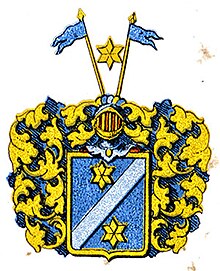Draft:de la Motte
Submission declined on 30 November 2024 by Iazyges (talk).
Where to get help
How to improve a draft
You can also browse Wikipedia:Featured articles and Wikipedia:Good articles to find examples of Wikipedia's best writing on topics similar to your proposed article. Improving your odds of a speedy review To improve your odds of a faster review, tag your draft with relevant WikiProject tags using the button below. This will let reviewers know a new draft has been submitted in their area of interest. For instance, if you wrote about a female astronomer, you would want to add the Biography, Astronomy, and Women scientists tags. Editor resources
|  |
| Submission declined on 4 August 2024 by CFA (talk). This draft's references do not show that the subject qualifies for a Wikipedia article. In summary, the draft needs multiple published sources that are: Declined by CFA 5 months ago.
|  |

de la Motte is an ancient French noble family introduced to the Swedish House of Knights in 1642 with the number 280.[1] The family was registered in the House of Knights of Finland in 1818 under the number 23.[2] The family is extinct.[3]
The family descends from the French nobleman Samson de la Motte who was in Swedish service as a major during the siege of Wollmar Castle in 1601. Samson de la Motte was granted the Lahis Manor in Sääksmäki Parish in 1600, which was one of Hogenskild Bielke's estates transferred to the state.[4] He was promoted to the rank of ryttmästare (former military rank of an army captain in the Swedish cavalry) in 1603, and in 1613 he received the Lahis and Kandola Manors in Sääksmäki, and was promoted to Major General. He died around 1620.[5]
Samson's son Carl de la Motte was a ryttmästare in the Viborg County Cavalry Regiment in 1643.[4] He became a naturalised Swedish nobleman in 1642 and was inducted into the Swedish House of Knights on behalf of the family in the same year under the number 280.[1] He became a major in 1647. Carl de la Motte had a son who continued the nobility on the sword side, Carl de la Motte. This later Carl (son of Carl de la Motte) attended the Riksdag in 1660. He was a Lieutenant Captain in the Åbo County Cavalry Regiment in 1675 and a ryttmästare in Colonel von Budberg's Karelian Cavalry Regiment. Carl de la Motte was married to Catharina Munck af Fulkila, daughter of the President of the Åbo Court of Appeal Johan Munck № 130 and Elisabeth Bure № 126.[4][5]
Most of the family was active in the military and lived in Finland. When Finland separated from Sweden, the line was matriculated in 1818 at the House of Knights of Finland at number 23.[2] Therefore, the line became extinct in Sweden. In Finland, the line went extinct on the sword side in 1886 and 1936 (after) on the distaff side.[3]
The word motte comes from the French word motte, meaning mound, referring to the word Motte-and-bailey castle, which serves as a defence facility on an artificial hill.[1]
References
[edit]- ^ a b c Bäckmark, Magnus. Riddarhusets vapensköldar Band I Medeltid och vasatid. Stockholm: Riddarhusdirektionen, 2019.
- ^ a b "Ätter och vapen - Finlands riddarhus".
- ^ a b "de la Motte". Minerva.
- ^ a b c Ramsay, Jully. Frälsesläkter i Finland intill stora ofreden. Helsingfors förlagsaktiebolaget Söderström & C:o, 1909-1916.
- ^ a b Elgenstierna, Gustaf. Den introducerade svenska adelns ättartavlor II. af Chapman–Fägerstråle, Stockholm. P. A. Norstedt & Söners Förlag, 1926.

- in-depth (not just passing mentions about the subject)
- reliable
- secondary
- independent of the subject
Make sure you add references that meet these criteria before resubmitting. Learn about mistakes to avoid when addressing this issue. If no additional references exist, the subject is not suitable for Wikipedia.